HIPAA Compliance Checklist for 2025

SaaS operations management goes beyond just properly executing daily enterprise tasks. It helps optimize SaaS costs and reduce resource waste. However, if you lack a centralized SaaS management process, it could impact your enterprise's operational efficiency and productivity.
In many enterprises, employees use various SaaS tools without IT approval for flexibility and ease of use. However, this can lead to disorganization and inefficiency in managing these tools.
It may disrupt operations, reduce productivity, and increase costs due to shadow IT and redundant applications. Poor management can also result in data breaches, compliance issues, and contract disputes.
So, how can you streamline the SaaS management in your enterprise? The best way is to enable SaaS ops management practices to structure and optimize the use of these SaaS tools effectively.
If you're unsure why managing your enterprise's SaaS operations is crucial and how to do so effectively, continue reading this article.
TL;DR
- SaaS ops management optimizes costs, improves security, and enhances operational efficiency by centralizing and streamlining SaaS tools.
- Neglecting SaaS ops management can lead to higher costs, security vulnerabilities, inefficiencies, and missed opportunities for innovation.
- Effective SaaS management involves monitoring usage, automating workflows, optimizing software performance, and ensuring compliance with data protection laws.
- CloudEagle.ai provides a comprehensive SaaS management platform with features like cost optimization, license harvesting, and automated provisioning.
- Investing in SaaS ops management is essential for sustaining long-term business success, improving productivity, and reducing operational risks.
What is SaaS Ops Management?
SaaS ops management is the process of supervising the procurement, utilization, provisioning, and optimization of SaaS apps within an enterprise. This process ensures that SaaS tools work effectively, boost productivity, cut costs, and improve security.
Effective SaaS ops management includes centralizing SaaS management. It also includes optimizing usage and costs, streamlining workflows, and ensuring security and compliance.
This list encompasses different aspects of SaaS ops management.
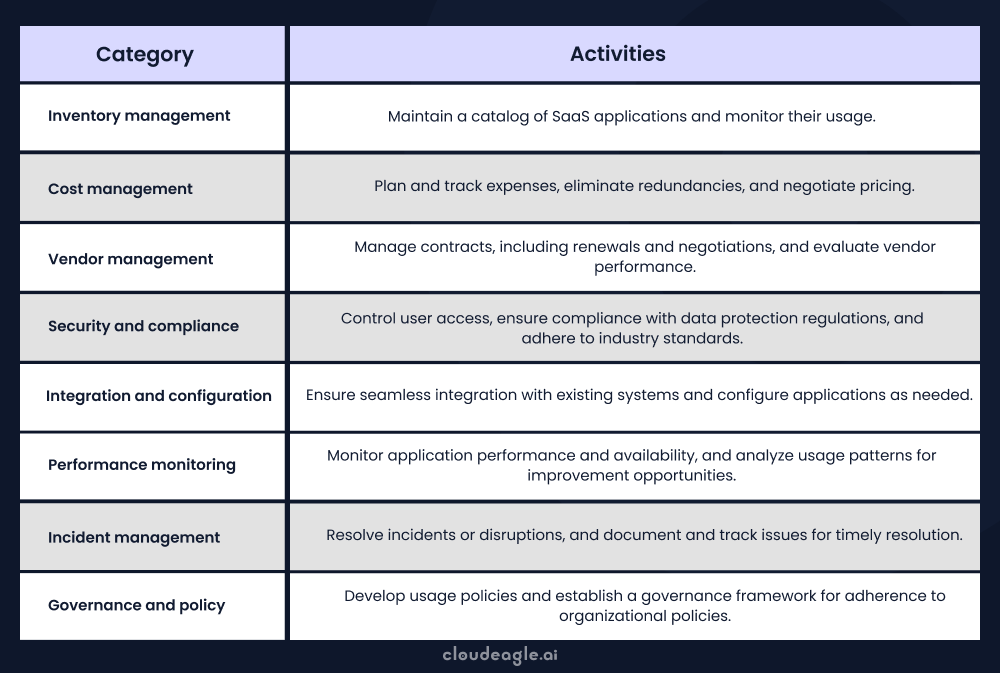
The Costly Consequence of Neglecting SaaS Ops Management
If you neglect SaaS ops management, it will lead to:
1. Increased costs: Without proper management, your enterprise will incur unnecessary costs. It can occur due to unused licenses, inefficient resource allocation, and lack of supervision on subscription costs.
2. Security vulnerabilities: It can leave enterprises vulnerable to security breaches and data leaks. These loopholes become the reason for potential financial losses, reputational damage, and legal liabilities.
For instance, in 2019, Capital One experienced a major data breach due to a misconfigured firewall in their cloud-based infrastructure.It exposed the personal information of over 100 million customers, causing financial losses, reputational damage, and legal issues.
3. Operational inefficiencies: Inadequate SaaS ops management results in operational inefficiencies, such as manual errors, slow performance, and downtime. These inefficiencies hinder productivity and impact business operations.
4. Missed opportunities: Failure to effectively manage SaaS operations results in missed opportunities for innovation, growth, competitive advantage, and cost optimization. You might miss integrating new features or updates for your enterprise's SaaS stack. It could improve services or streamline processes.
5. Regulatory consequences: If you don't follow data protection laws and fail to manage SaaS operations properly, you might face fines or legal trouble. This can also damage your reputation and reduce trust among customers and stakeholders.
What is the Need for SaaS Ops Management?
SaaS ops management is essential for a few key reasons.
Simplify Management: It eliminates the manual process of managing different SaaS apps using spreadsheets. If your IT teams handle this process manually, it can be time-consuming and prone to errors.
Automating SaaS ops management reduces complexity, improves efficiency, and ensures better governance across the IT environment.
Optimize Software Use: SaaS ops management ensures that all software applications are utilized to their full potential. By managing and monitoring these tools, enterprises can ensure they get the best performance and features out of their subscriptions.
Enhanced Efficiency: This process helps enterprises maximize SaaS benefits while maintaining safety and efficiency. It streamlines tasks, enhances efficiency, and supports growth with scalable solutions. It also ensures compliance with data protection laws and industry standards.
Improve Productivity: Streamlining how employees access and use software reduces the time and effort needed to manage multiple applications. This leads to smoother workflows and allows employees to focus on their primary tasks, boosting overall productivity.
What Are the Challenges of SaaS Ops Management?
Although it may seem straightforward, SaaS ops management comes with its own set of challenges.
1. Complexity: Managing many SaaS apps simultaneously is hard because each app works differently. They have unique functionality, rules, and ways of connecting with other apps. You must create an advanced business-aligned plan for the IT team to handle them all.
2. Cost Control: Tracking spending on SaaS apps can be tricky. Sometimes, you might end up paying for things your enterprise doesn't even use or need. With good SaaS ops management, you can use resources wisely, get better deals, and avoid wasting money.
3. Security Risks: SaaS apps handle critical data like customer information and financial transactions. If not managed properly, they can pose risks. To maintain safety, you must ensure the data is secure from hackers and comply with regulations.
4. Operational Efficiency: Making everything run smoothly is tough without good SaaS management. It's like keeping all the moving parts of a machine working together. Having a clear plan and seeing how things are going helps a lot.
5. Inefficient Lifecycle Management: Managing the lifecycle of SaaS applications can be tough if it’s not organized. It involves acquiring, setting up, maintaining, renewing, and discontinuing software. Inefficiencies can lead to wasted resources, like paying for unused licenses or missing renewal deadlines.
6. Scalability: When a business grows, it needs software to grow with it. SaaS management makes adding more software licenses or users easy without causing problems. It keeps everything flexible so the business can keep growing smoothly.
What Are the 4 Key Elements of Saas Ops Management?
The main elements of SaaS ops management include:
1. Provisioning and Deployment: Effective SaaS ops management involves setting up new software and working with what's already there. It includes creating user accounts, setting up how things should work, and making sure everything fits together.
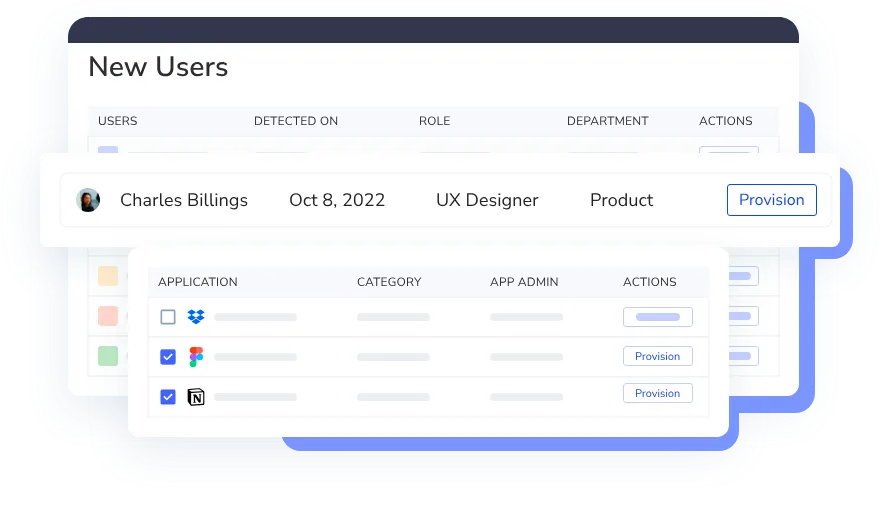
2. Monitoring and Performance Optimization: It is crucial to monitor how well the software is doing and make it work better. This means checking how long it's up and running, how fast it responds, and how much it uses resources like memory and space. It means making sure everything runs smoothly and doesn't waste anything.
3. Security and Compliance: Ensure the software is safe and adheres to your enterprise's policies. It involves ensuring only the right people can use it, keeping data secret with passwords and encryption, and checking regularly for any problems.
4. Cost Management and Optimization: Keeping track of how much resources are spent on the SaaS and ensuring it's worth it. It means watching spending, ensuring nothing is wasted, and talking with the people who make the software to get the best deal.
What Are The Key Strategies For Effective Saas Ops Management?
Some specific strategies for effective SaaS ops management include:
1. Centralized Visibility and Assessment: The first strategy for effective SaaS ops management for your enterprise is to gain complete visibility into your SaaS stack. You cannot rely on spreadsheets anymore; you must adopt an automated SaaS management platform to get a bird's-eye view of your SaaS stack.
When you integrate the SMP with your enterprise's existing SSO, HRIS, or financial systems, the tool extracts the app usage data and provides complete SaaS visibility.

You can monitor shadow IT and configure alerts to prevent unsanctioned purchases in early stages. Proactive shadow IT prevention will help you avoid the risk of SaaS sprawl.
2. Usage Monitoring and Optimization: If you have real-time SaaS usage data, you can easily optimize licenses based on actual needs. By analyzing usage data, you can identify opportunities to reduce costs, improve efficiency, and allocate resources effectively.
3. Application Rationalization: Rationalizing your enterprise's tech stack is a good practice to undertake periodically to keep your SaaS applications rationalized. It involves evaluating and improving an enterprise's software applications.
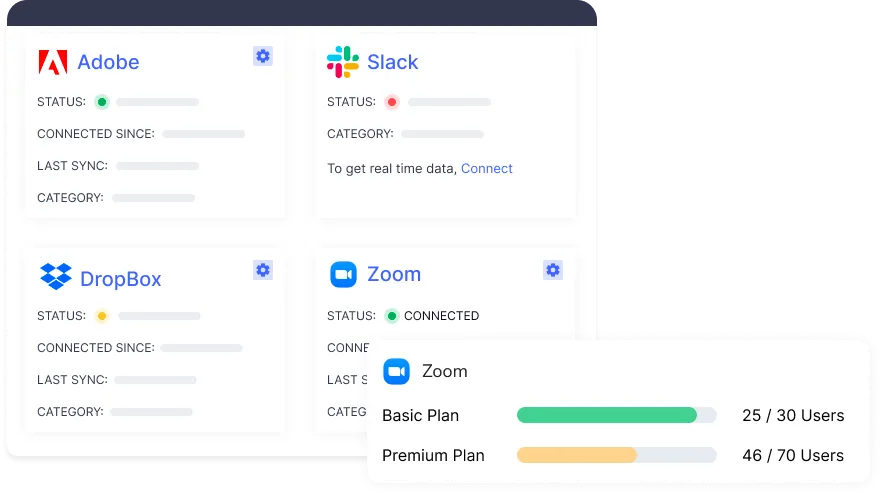
It's like cleaning out your SaaS stack to keep only what you need and eliminate what you don't. This helps save money, reduce complexity, and make things run smoothly.
4. License Harvesting: To avoid wasting all the SaaS licenses in your enterprise, the best practice is to opt for license harvesting. It helps you identify all the unused licenses and the underutilized ones.
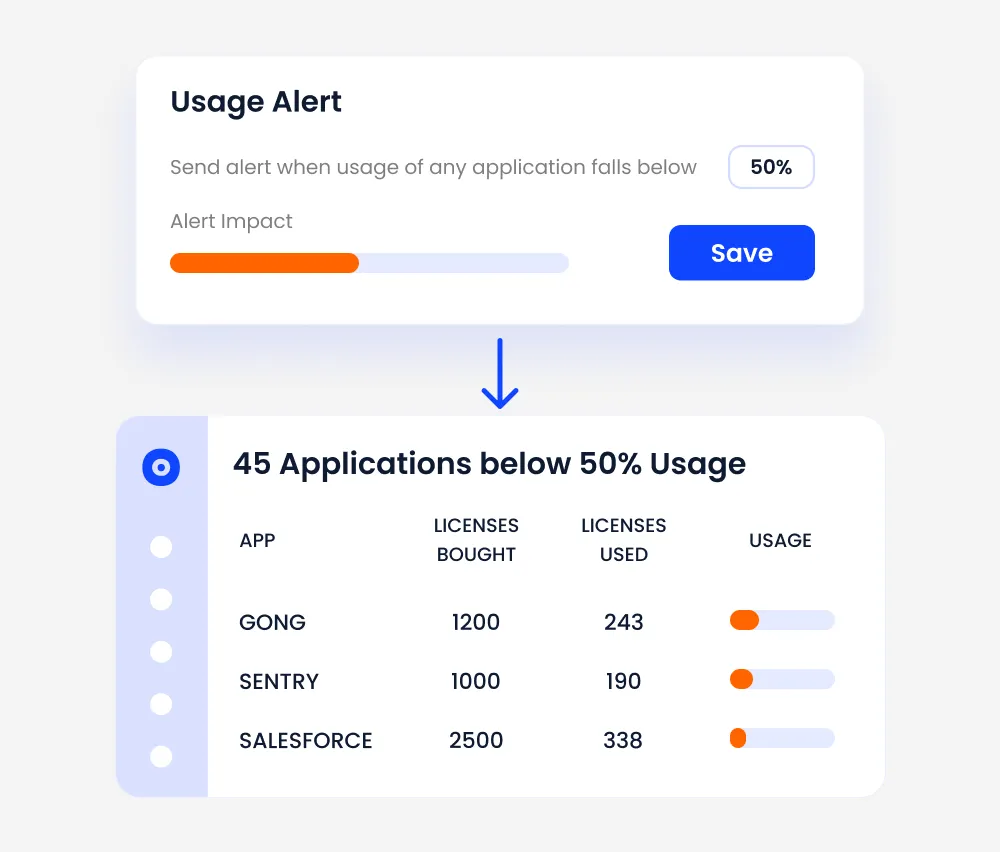
Thus, you can automate the process and reclaim the unused licenses, reallocating them to others when needed. By reclaiming unused licenses and putting them to good use, you save money and ensure you're not paying for things you don't need.
5. Enabling Security and Compliance: You should implement proper security measures and ensure compliance with data protection regulations for effective SaaS Ops Management.
It includes enforcing access controls, encrypting sensitive data, and conducting regular security audits to mitigate risks and protect against unauthorized access or data breaches.
6. Cost Management: To effectively manage SaaS costs, optimize usage, and negotiate pricing with vendors, it's crucial to eliminate unused licenses, consolidate subscriptions, and explore alternative pricing plans.
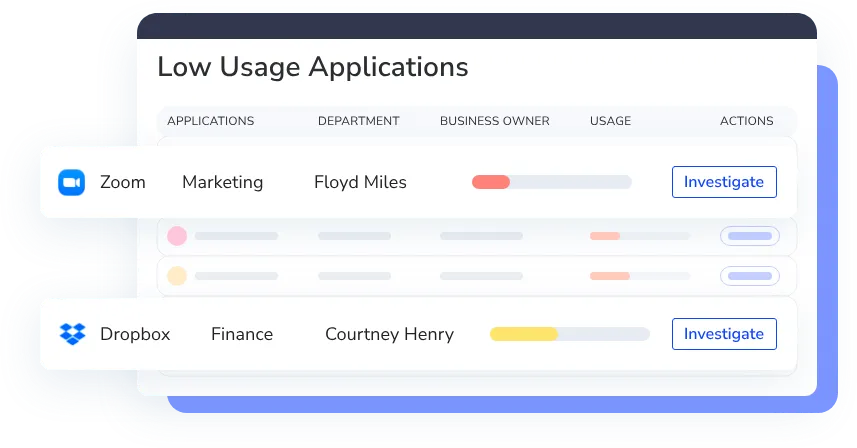
Cost optimization begins with smart negotiations. You must employ the right negotiation strategies to prevent overspending. Leverage price benchmarks to ensure you pay the right price for the applications.
7. Disaster Recovery and Business Continuity: To uphold business continuity, create contingency plans to address SaaS application outages or service disruptions. You can implement data backup and recovery strategies to ensure critical application data can be restored quickly during a disaster.
8. Employee Training and Awareness: You must train and raise employee awareness about SaaS best practices, security protocols, and compliance requirements. Educating employees helps reduce security risks, maximize productivity, and ensure proper usage of SaaS applications.
7. Using a Centralized Management Platform: Leveraging a centralized SaaS management platform streamlines SaaS ops management processes. It provides a single dashboard for monitoring usage, managing costs, and enforcing security policies.
The platform extracts app usage data when integrated with your enterprise's existing SSO, HRIS, or financial systems, providing complete SaaS visibility.
Additionally, these tools facilitate better collaboration across teams. Enabling centralized management simplifies administrative tasks, improving efficiency in managing SaaS applications.
Benefits of SaaS Ops Management
Proper SaaS ops management offers the following benefits for your enterprise:
Cost Savings: SaaS ops management helps identify duplicate, redundant, and free apps in your system. You can even dive deeper into individual app usage, identify unused licenses, and optimize them. You can also effectively track renewals and renew your contract on time, leading to significant savings.
Stronger Security: With SaaS ops management, you can keep your business's data safe from hackers and other cyber threats. It does this by setting up strong passwords. It ensures only the right people can access your data, and regularly checking for any problems.
Work Faster: SaaS ops management streamlines your team's most used workflow and saves valuable time. It automates repetitive tasks like user provisioning, deprovisioning, procurement, renewals, and license harvesting. Automating these repetitive tasks with workflows ensures that teams complete their tasks faster.
Grow Easily: You can add more software or users as your business grows. It can quickly set up accounts for new employees and add them to the right software tools. Plus, it helps you choose new software that fits your business needs and integrates smoothly with your existing tools.
What Is SaaS Operations Management Software?
SaaS Operations Management Software is a specialized tool designed to help IT, security, and finance teams manage, monitor, and optimize their enterprise’s entire SaaS ecosystem. It provides visibility and control over all SaaS applications used across the company, covering everything from user provisioning to spend tracking and security policy enforcement.
Key Features of SaaS Operations Management Software
- Complete App Discovery: Automatically detects all SaaS applications being used across the enterprise, including unsanctioned or shadow IT tools.
- User Lifecycle Management: Automates user provisioning, deprovisioning, and access management based on roles, departments, or custom workflows.
- License & Usage Tracking: Monitors license utilization across all tools to identify unused or underused licenses and reduce SaaS waste.
- Access Control & Policy Enforcement: Applies role-based access controls, least privilege principles, and MFA settings across all SaaS apps to strengthen security.
- Integration with HRIS & Identity Providers: Syncs with platforms like Workday, Okta, Azure AD, and Google Workspace for real-time updates to access permissions.
- Security & Compliance Monitoring: Offers audit logs, activity tracking, and compliance checks for frameworks like SOC 2, GDPR, and HIPAA.
- Automated Workflows & Approvals: Enables custom approval flows for app access requests, renewals, and procurement to prevent maverick spend or policy violations.
Cloudeagle.ai - A Comprehensive Saas Ops Management Platform
CloudEagle.ai is a SaaS management and procurement platform. This can be your go-to solution for optimizing your enterprise's SaaS ops management.
With its advanced features and automated workflows, you can streamline and centralize your enterprise's SaaS management and take complete control of your SaaS stack.
Complete SaaS Discovery: If your company doesn't track all its software apps, your IT team can struggle to manage their app data properly.
CloudEagle.ai provides a bird's eye view of your entire SaaS stack. The tool integrates with your internal systems like SSO, HRIS, inance systems and applications through direct API connectors.
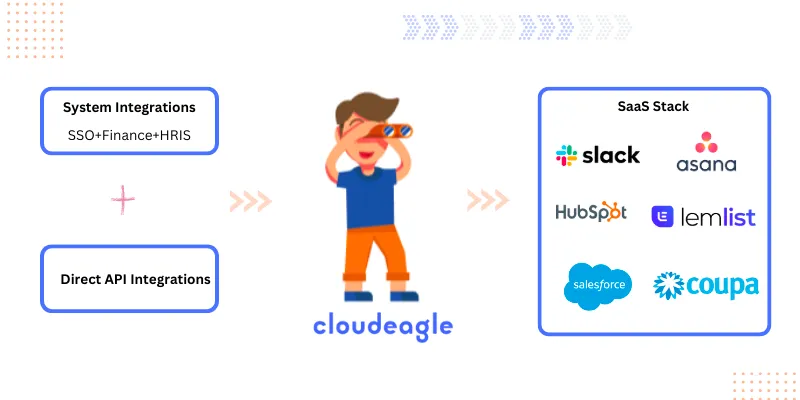
Also, you can access every detail about SaaS apps usage, spending, vendors, users, and licenses from a single dashboard.
By analyzing this data, you can make better decisions, such as determining which SaaS apps are necessary and which need to be optimized, consolidated, right-sized, or abandoned.
For example:
- If multiple applications are used for the same task, you can decide to eliminate redundant apps (Shadow IT).
- If an application hasn't been logged into for a long time, you can alert the app owners and revoke or confirm access based on your requirements.
- Additionally, if there are low-usage SaaS applications, you can decide to revoke their licenses.
Cost Optimization: By integrating CloudEagle.ai with your internal systems, you gain insights into SaaS usage and spending. It provides precise spending breakdowns across departments and accurate user activity analyses.
The tool continuously monitors cloud costs in real-time. It pinpoints areas for optimization without disruptions. With this data, you can make informed decisions to achieve cost efficiency.
It also tracks renewals to ensure contracts are renewed on time. Using CloudEagle.ai, you can identify duplicate, free, and redundant apps and decide whether to keep, retire, or renew app licenses based on their effectiveness and relevance.
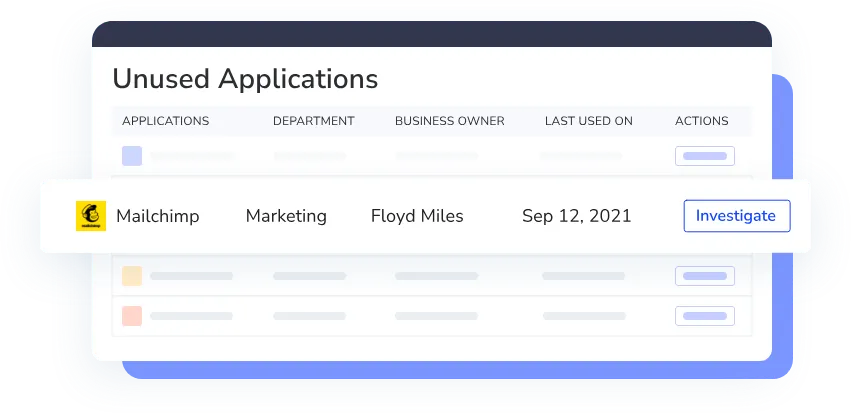
Also, you can set proactive alerts to get reminders before the SaaS contract renewal date. It ensures you don't miss out on important deadlines.
Assisted Buying: If your team doesn't have the time and bandwidth to do negotiations, use CloudEagle.ai's assisted buying services.
CloudEagle.ai's team of SaaS experts will thoroughly analyze your requirements, conduct extensive market research, and utilize pricing benchmarks to facilitate successful negotiations.
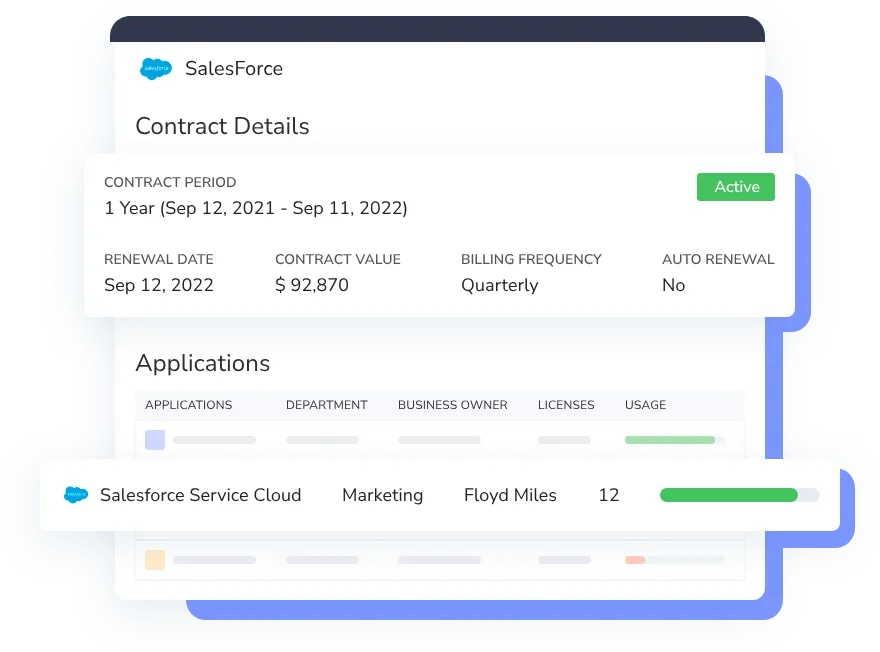
Check this inspiring success story where Nowports secures 34% Savings with CloudEagle.ai's effective negotiation.
Further, you can use CloudEagle.ai's automated workflows to simplify your SaaS procurement process. You can automatically assign tasks, notify stakeholders through Slack, Email, and in-app notifications, and ensure timely approvals.
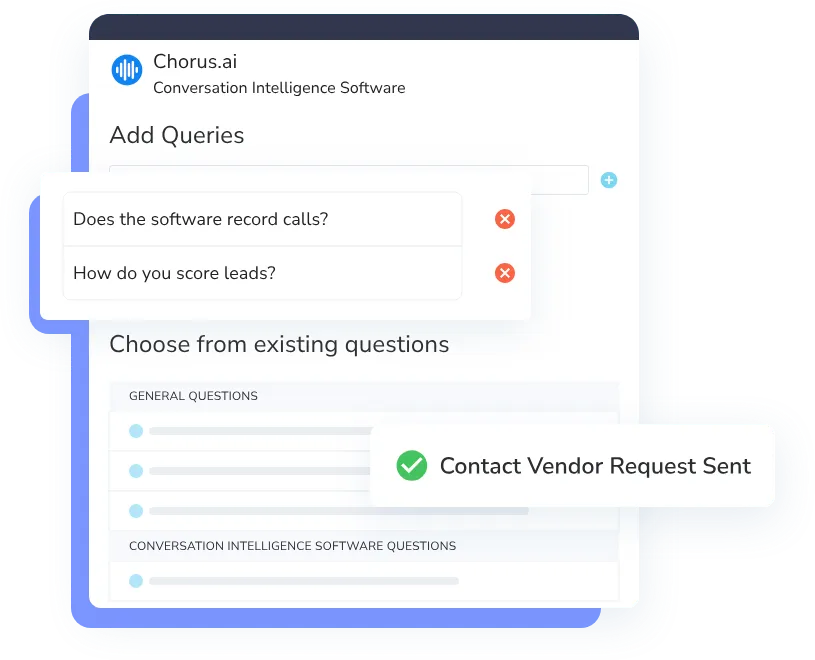
Also, you can access the "Slack for Procurement" bot that promotes collaboration and streamlines the entire procurement process. With immediate team connectivity, communication accelerates, reducing coordination time by up to 25%. Slackbot will speed up workflows, slash turnaround times, and improve SaaS procurement efficiency.
License Management: CloudEagle.ai's direct integrations will enable you to see purchased licenses for each application and their usage.
Instances of underutilization can impact your ROI. Fortunately, you can leverage CloudEagle.ai's license reclamation workflows to deprovision users for low usage and harvest those licenses.
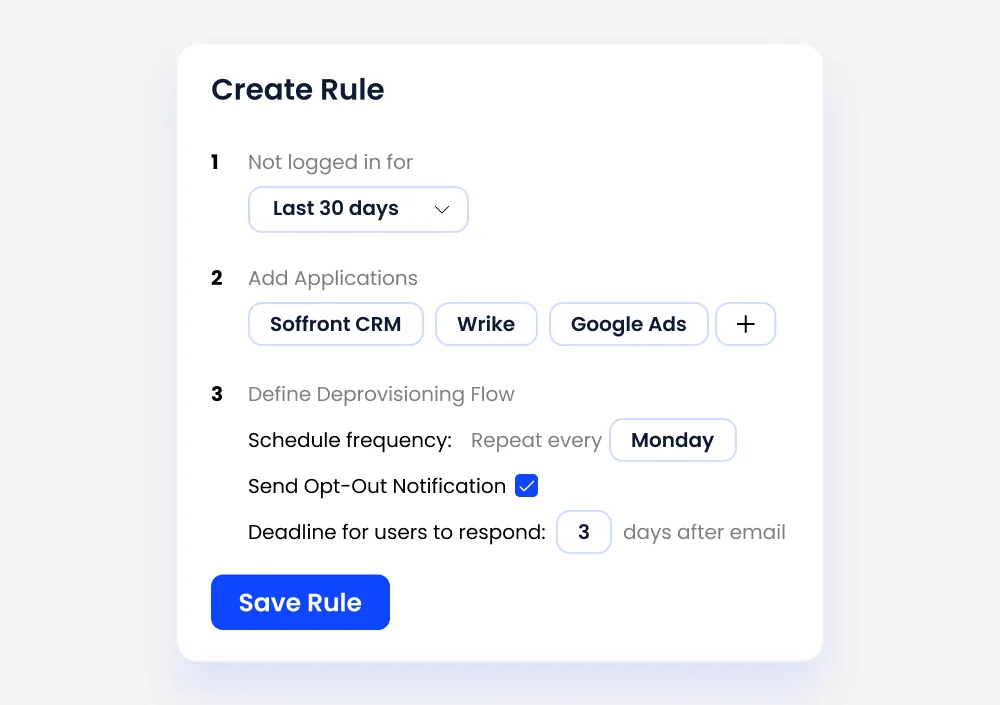
With CloudEagle.ai's license harvesting workflows, you can ensure that the purchase licenses are optimized and utilized properly.
To understand how useful this feature is, check out this case study, where Remediant discussed how they tracked app usage, licenses, and spending data using CloudEagle.ai.
User Provisioning and Deprovisioning: Use CloudEagle.ai's auto-provisioning workflows to automate user provisioning within your enterprise.

These workflows will enable your IT team to reduce reliance on time-consuming manual processes and save over 500 hours annually.
With 500+ integrations, you can create rules for provisioning, modifications, and deprovisioning, streamlining user lifecycle management. CloudEagle.ai seamlessly integrates with your SSO and HRIS, consolidating all user data into a centralized location.
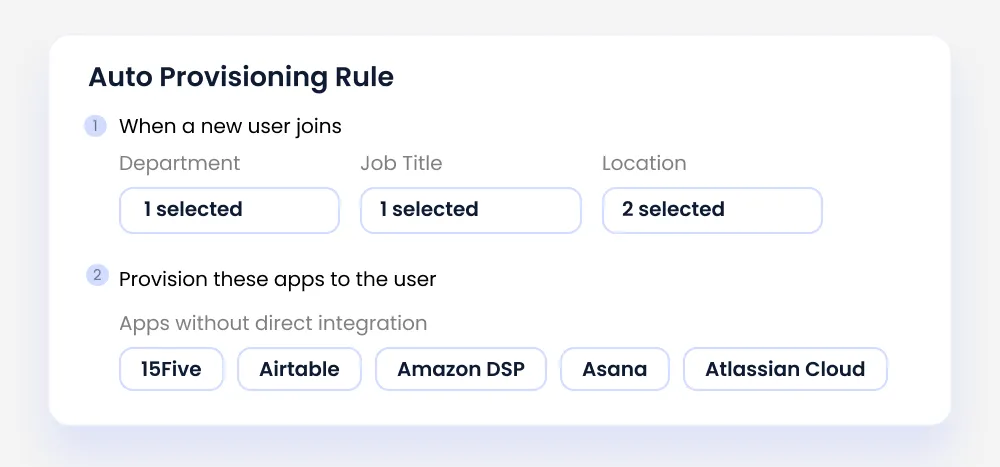
You can optimize the SaaS access granting process using CloudEagle.ai. You can use the tool to provide SaaS access during employee onboarding. Also, you can create one-click deprovisioning workflows for revoking SaaS access from employees during offboarding.
Check out Alice Park's testimonial from Remediant. She found CloudEagle.ai effective in streamlining employee onboarding and offboarding. Previously, she spent significant time manually managing each application. After integrating CloudEagle.ai with their HRIS systems, she could organize all users in one place, saving valuable time.
Conclusion
If your enterprise uses many SaaS tools, you must prioritize SaaS ops management. By focusing on this, you ensure your tools run smoothly and efficiently. It also helps your team work better and avoid disruptions.
It maximizes your software investment by ensuring you use all features effectively. It helps cut unnecessary costs and maintains security. Investing in SaaS ops management helps sustain operational efficiency and supports long-term business success.
If you want to streamline SaaS ops management, consider CloudEagle.ai. This all-in-one SaaS management tool handles everything from managing your SaaS stack, user provisioning and de-provisioning, license, renewal, and vendor management to ensuring compliance and security.
Schedule a demo with CloudEagle.ai to explore best practices for your SaaS operations management needs.
FAQs
1. What is SaaSOps?
SaaSOps is the practice of managing, securing, and automating SaaS applications across their lifecycle. It centralizes control to streamline onboarding, ensure compliance, and reduce risks and costs.
2. What is SaaS operations management?
This involves deploying, securing, updating, and optimizing SaaS apps. It ensures proper access control, cost efficiency, and compliance across the enterprise.
3. What is SaaS management software?
These tools automate SaaS tasks like license tracking, user provisioning, and usage monitoring. They reduce manual work, prevent waste, and boost security.
4. What is a SaaS operating system?
A SaaS OS is a unified platform that connects and manages all SaaS tools with single sign-on, centralized access, and automated workflows for seamless operations.

%201.svg)







.avif)




.avif)
.avif)




.png)









